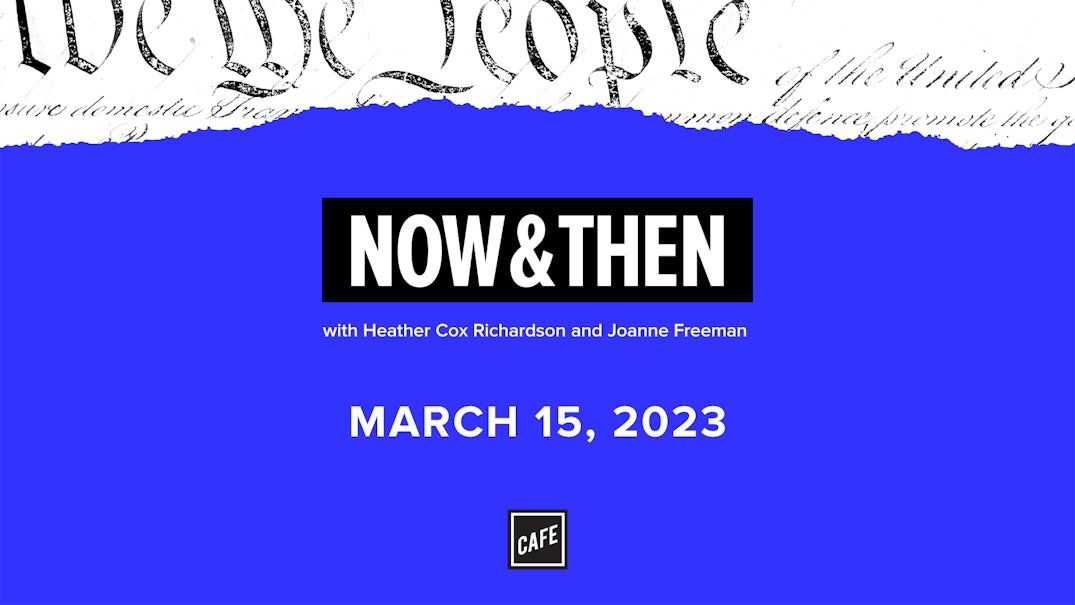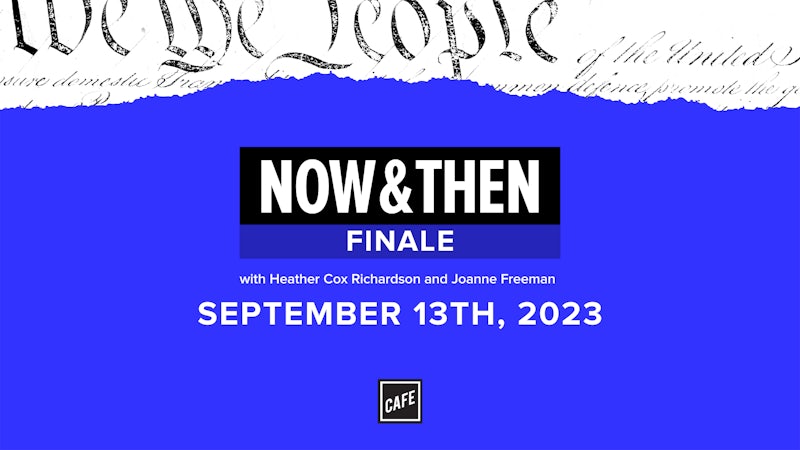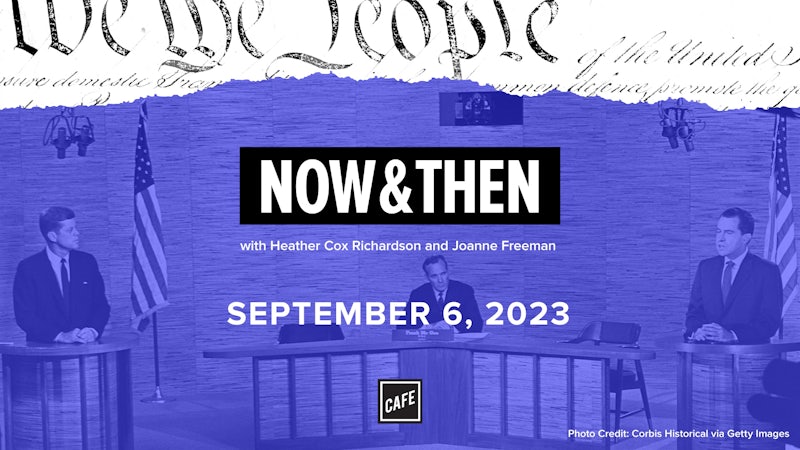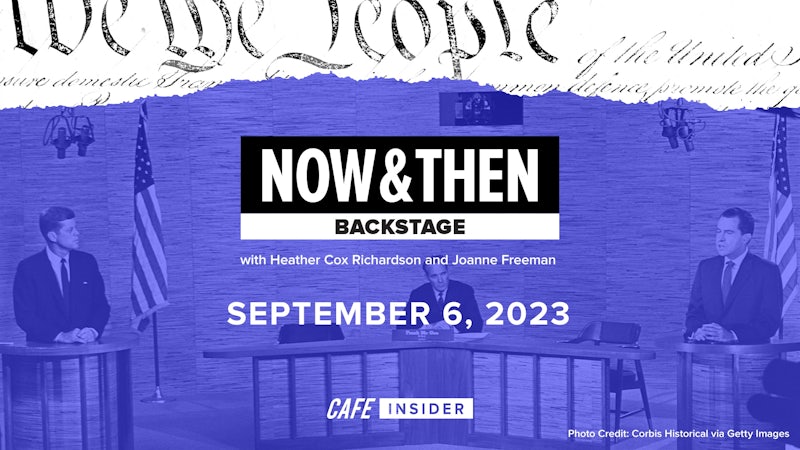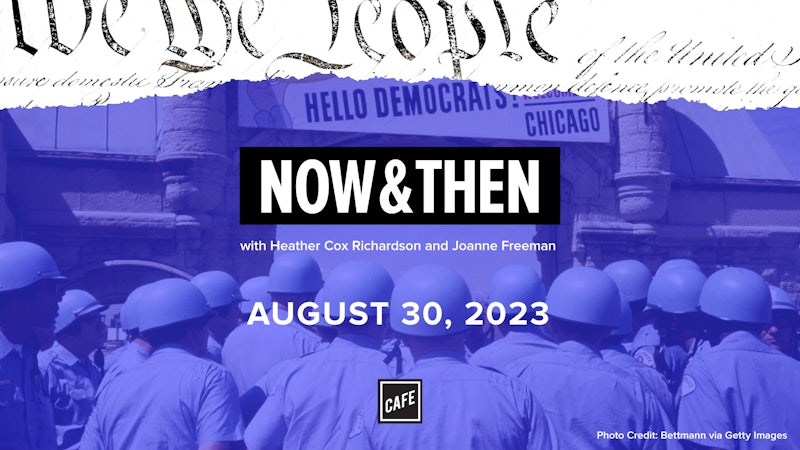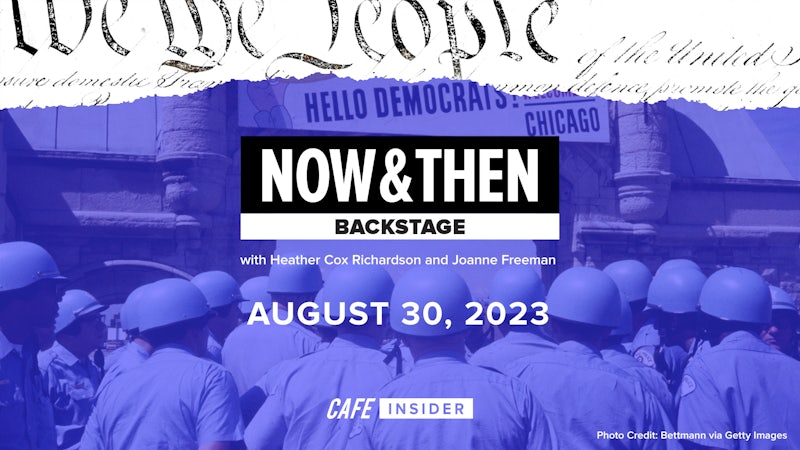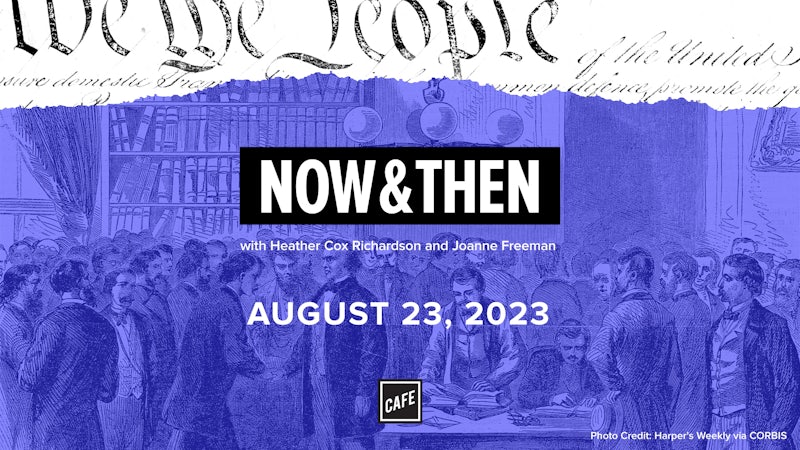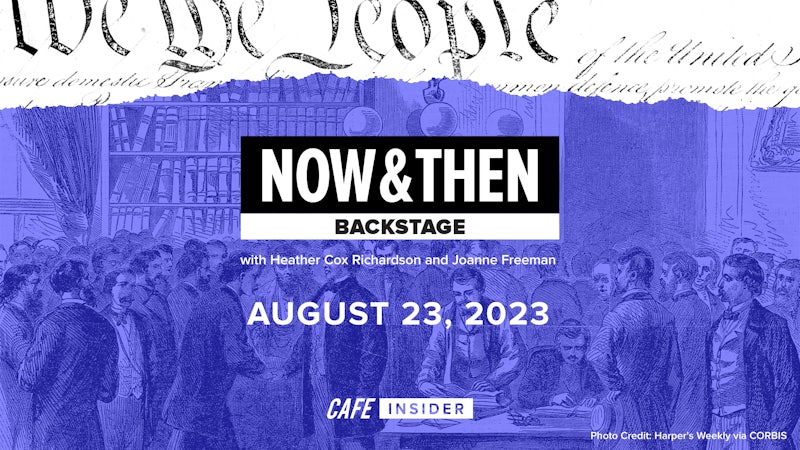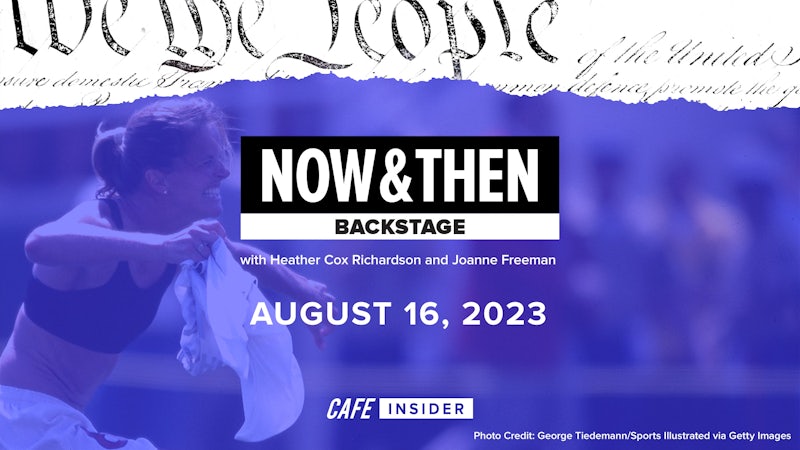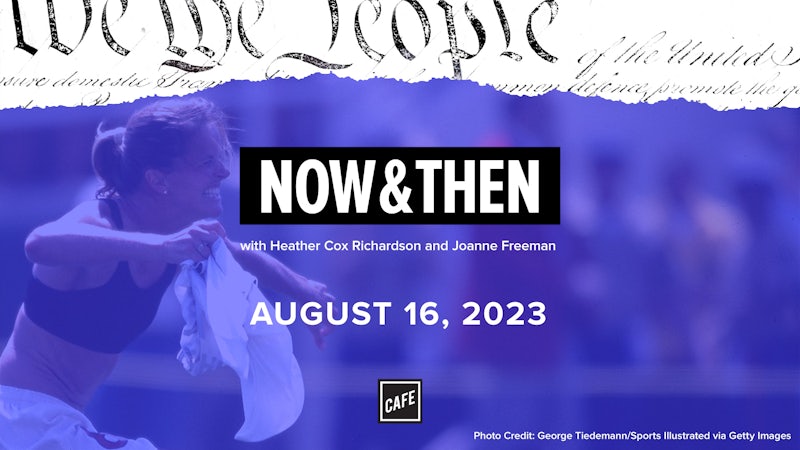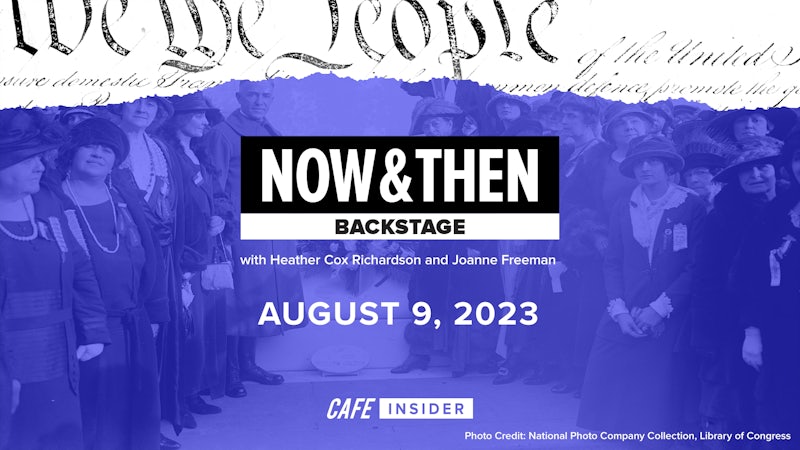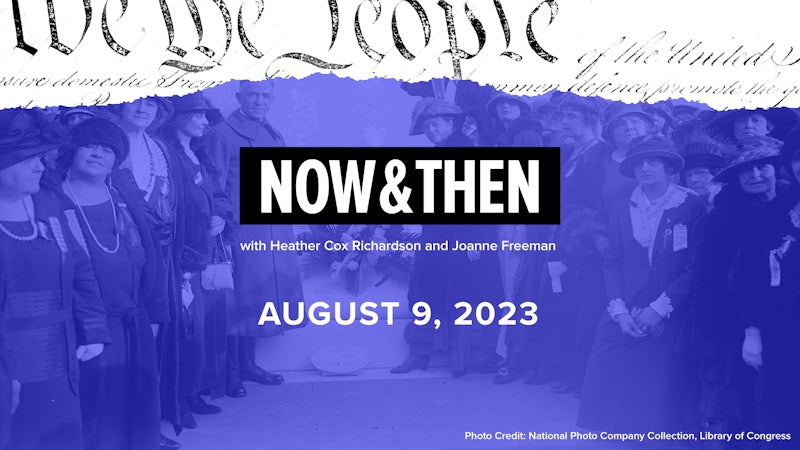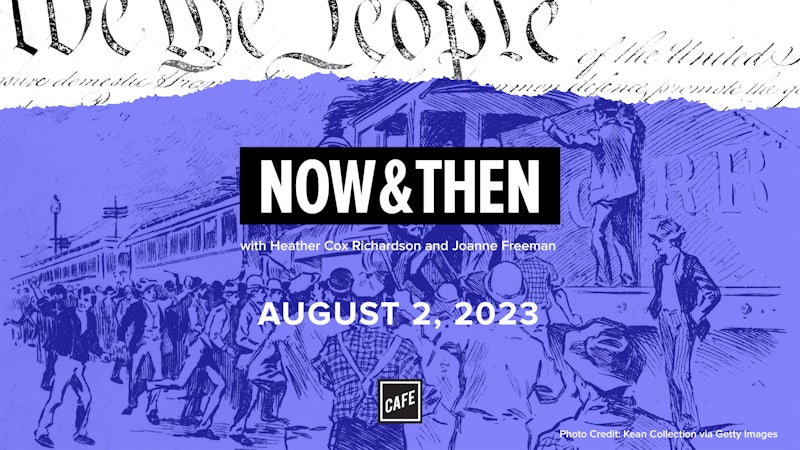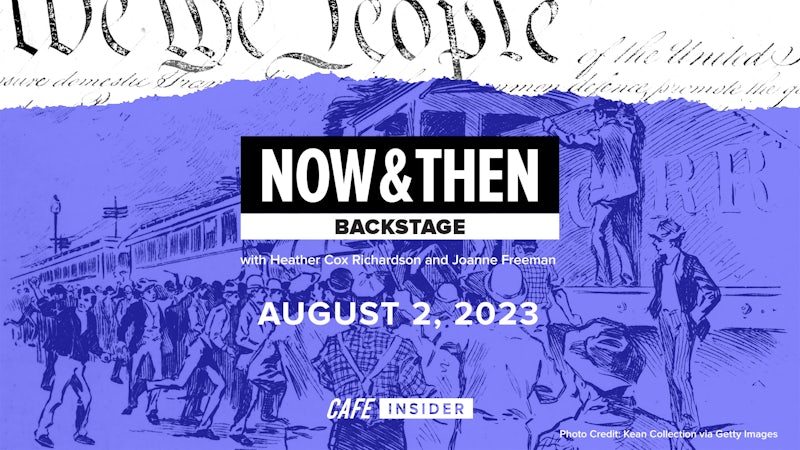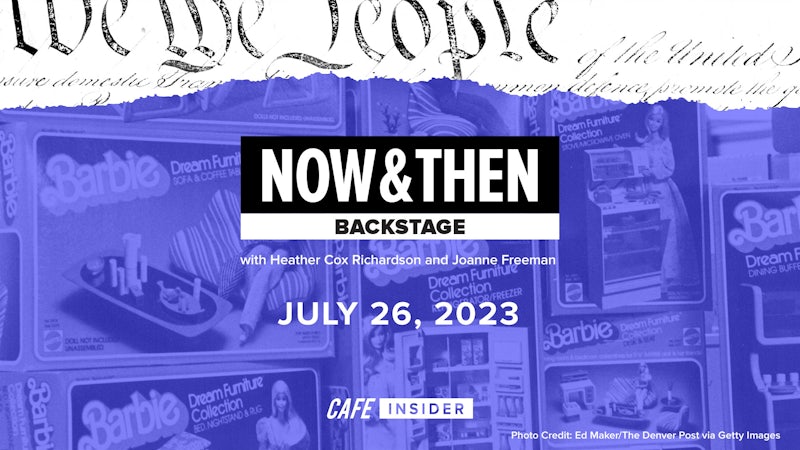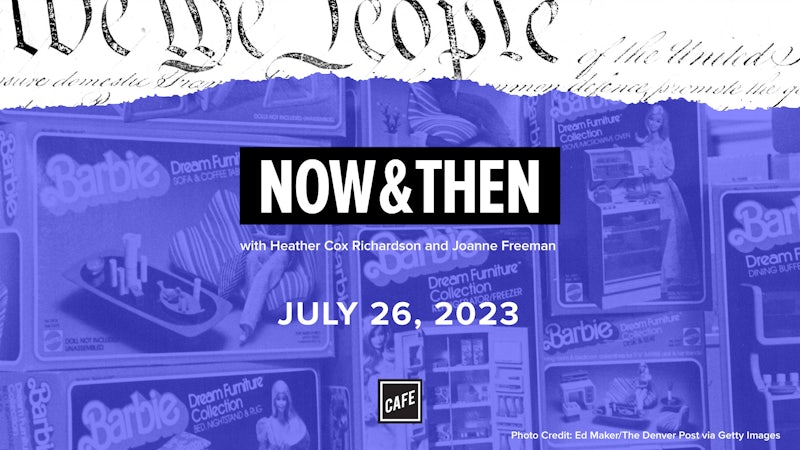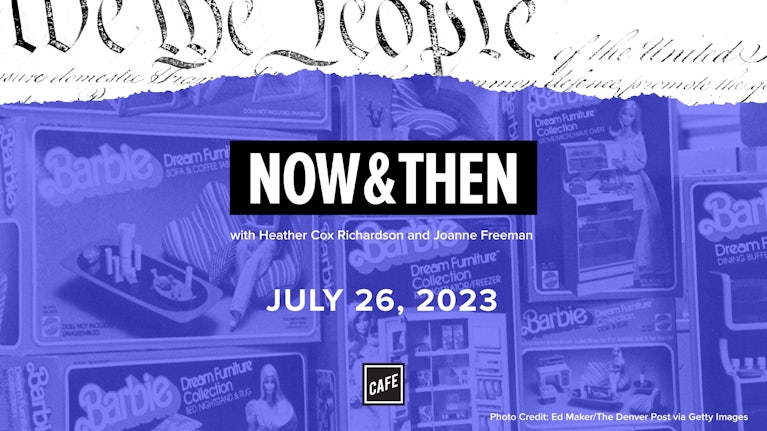Heather Cox Richardson:
From Cafe and the Vox Media Podcast Network. This is Now & Then. I’m Heather Cox Richardson.
Joanne Freeman:
And I’m Joanne Freeman. This week’s topic is in part suggested by a listener, and let me explain what I mean by that. Two weeks ago we had an episode at the start of Women’s History Month on women fighting legal battles for their rights. It was called Women Changemakers Three Legal Battles, and we got a big response to that, which is interesting in and of itself. But we also had one listener who wrote in with a great idea, why don’t you do an episode about women journalists? And so today that is what we are going to address. And I want to point out here, if you think that when you send social media posts to us or send email that we are ignoring you, we not, we actually will look at them and discuss them and here, we can now vouch for it with this episode.
Now, before we plunge into that topic, let’s just talk really briefly on the state of women writers and journalists today. On the one hand, in the semi recent past, there’s been a good deal of progress. So for example, according to a study by the American journalist in 2022, 40% of American journalists are women, which is a remarkable number considering that in 1971 that number was 20% of American journalists were women. And women increasingly are in very visible roles. Earlier this month, there’s kind of an impromptu moment during a White House press briefing that highlights just what we’re talking about here. Karine Jean-Pierre, the first black woman to serve as White House Press Secretary remarked that it was the first time she remembered seeing all women in the front row in the press briefing room, and the journalist included CNN’s Kaitlan Collins and NBC’s Kristen Welker among others. So just in that alone, you can see how long away we’ve come from Helen Thomas, she died in 2013 and for a while was the only woman in the White House Press Corps.
Heather Cox Richardson:
It’s been a really dramatic change and I think it jumped out, especially during the Trump administration when it was very clear he had a real problem with female journalists, especially female journalists of color, and they really stood up to him. That’s actually when Yamiche Alcindor really got onto my radar screen, watching her just push and push and the other women in the corp standing up for each other. And that points out just how steep the barriers still are for a lot of women to make it to the top of the profession and the pushback they’ll get, which we’ll talk a lot about this episode. But also women in the profession face something very different than men do, and that is the online abuse that comes at them now because of the rise of social media. So people are studying this more and more as more women report the kinds of abuse that they get online.
And a study published in February by the International Center for Journalists investigated how one foreign journalist, an Indian investigative reporter named Rana Ayyub was abused online and they discovered that she was a subject of more than, get this, 13 million threatening tweets over a three year period because she had reported on the extra judicial killings of Muslims in India during the riots of 2002, and that implicated the current Prime Minister Modi, and since then she has become the target of what they’re calling viral smear campaigns. And here’s what the studies lead researchers said about those findings. Dr. Julie Posetti said, “Our findings graphically illustrate the chilling ways in which patriotic trolls and foreign states target women journalists online in ways designed to discredit them, their journalism and the news outlets they report for.” And that’s really true. The idea of undermining, especially by right wing governments, undermining the voices of women and insisting they don’t belong in the public sphere is absolutely a thing now.
Joanne Freeman:
It’s interesting because in my reading some of the material that prepared by our wonderful producers for this episode and then researching on my own, I got really angry and it’s not as though I haven’t got angry before, but this was a sort of deep, visceral kind of anger because you’ll hear there are continuities between the strengths and talents and accomplishments of these women and continuities in the precise thing that we were just talking about when it comes to 13 million threatening tweets with ongoing, what now I suppose the slang is fire hoses of abuse and attack and they don’t necessarily end when they should end and they build, right? If you’re attacking a woman, the simple fact that you’re attacking a woman can keep the momentum going long beyond what the specific thing that woman did was. And I think we’re going to see some of that today too.
Heather Cox Richardson:
Our first candidate here, Anne Royall, sets this up so well because her offense was simply reporting the news that other people didn’t want to have get out, if you will.
Joanne Freeman:
For reporting the news and having an opinion and reporting with the opinion and being a woman gasp.
Heather Cox Richardson:
All right, so let’s get into this. Instead of just ringing our hands over this woman, we should actually say why we’re wringing our hands over her.
Joanne Freeman:
So Anne Royall, as luck would have it, her life pretty much spans over a remarkably eventful period in American history. She’s born in Maryland in 1769. Her family moves to Western Pennsylvania to a sort of frontier-esque condition when she’s a toddler.
Heather Cox Richardson:
Did you really just say frontier-esque condition?
Joanne Freeman:
I did. That’s what came out of my mouth, I was like, well, it’s not really a frontier, and I edited myself as I said it.
Heather Cox Richardson:
Okay. She lived in a frontier-esque condition, otherwise known as like the-
Joanne Freeman:
Western Pennsylvania
Heather Cox Richardson:
Yeah, there you go. There you go.
Joanne Freeman:
And then West Virginia and her family were servants in the mansion of a rather reclusive revolutionary war hero and enslaver named William Royall. And ultimately, although he was 20 years Anne’s senior, the two eventually married, they apparently lived happily together until William died in 1812 and after many years of contentious litigation over William’s estate and who would benefit from it? Anne was basically entirely dispossessed of her inheritance. So she’s left without means and single. So in the mid 1820s, when she’s around 55 years old, she begins traveling first around the south and then through a number of other regions observing and sometimes offering opinions about what she sees in a variety of different ways. In the end, she wrote 10 travel volumes about her travels and she became rather well known for those volumes. In 1827, she also published first under a pseudonym, the Traveler, a novel called The Tennessee.
She began to produce the first of eventually 2000 pen portraits of notable Americans. Now, in addition to all of this writing and traveling, Royall still was fighting to claim something from her husband, in this case her husband’s pension. And it was through this lobbying that she first met John Quincy Adams in 1824 when he was Secretary of State, and Adams supported her petition before Congress, helped her somewhat in getting access to things for her pen portraits, but despite the fact that he was supportive of her, he has an amazing diary, truly if you are a historian in a writing about this period, his diaries remarkable.
Despite all of the support he has for her he writes in 1827 about her “Royall continues to make herself obnoxious to many persons tolerated by some and feared by others, by her deportment and her books treating all with a familiarity which often passes for impedance, insulting those who treat her with incivility and then lampooning them in her books, stripped of all her sexist delicacy, but unable to forfeit its privilege of gentle treatment from the other. She goes about like a virago errant in enchanted armor and redeems herself from the cravings of indigence by the notoriety of her eccentricities.”
Okay, this is from a supporter and this is noting how she’s treated, right? Heaven forbid she’s insulting people who are rude to her. Now, what’s interesting about her quest for that pension is at the same time that she’s doing all of this writing and she’s opinionated and out there acting and being a very successful journalist slash writer, she’s petitioning for this pension and really playing up the fact that she’s a widowed or as she put it, “little old woman.” She writes to the Arkansas Gazette in 1827 talking about how her turn toward journalism came about because she couldn’t get the inheritance or the pension, and she says, “I am a little old woman with a very keen pen it is said, fearless character and Frank Manors, I am the widow of a revolutionary hero who left me independent but was stripped of my all by villains and had no resource for my advanced age, then 50, but to take up my pen and then received the patronage of president’s, governors, generals, judges and statesmen, and without 1 cent of money or one change of Raymond When I set out, I have done this.”
And she becomes known, she’s becomes a public figure. She’s a supporter of the Jackson administration. She is highly distrustful of evangelical religion rising in this period. She thinks that among other things, they’re trying to silence their women, which interestingly enough, in the realm of politics, we have the rise of party politics and more white men are being included and women because it’s become almost like a sport, are being increasingly excluded.
Heather Cox Richardson:
Well, I actually think it’s important that she has been sort of almost a mascot, if you will, sort of tolerated, and people think she’s something a little odd and-
Joanne Freeman:
Eccentric.
Heather Cox Richardson:
Yeah, eccentric and they’re happy to let her be out there. Like Quincy Adams sort of supporting her in public and behind closed doors calling her noxious. That’s going to change, and she’s going to become a very public figure when she begins to push back against evangelicals for their subjugation of women. And all of a sudden she goes from being, “Oh, isn’t she a funny old thing,” to what they’re going to do to her?
Joanne Freeman:
Beginning with 1829, she ends up being indicted by a Washington grand jury for her journalism battle with an evangelical congregation that meets in an engine house near the capitol, known appropriately enough as the engine house congregation, and she’s indicted by a Washington grand jury using a leftover component of British common law that dubs her “a common scold.” What you would’ve done traditionally to a common scold. And what the jury pondered doing was that traditional punishment using a ducking stool, a wooden swing chair that would’ve dunked her into a body of cold water. We’re talking about 1829, and yet even then, this is antiquated and strange.
Heather Cox Richardson:
And a really interesting and important kind of punishment for a woman who is taking a stand against the rise of organized religion, taking over politics. They’re going to punish her in the sorts of ways they used to punish outlying women, including people accused of being witches.
Joanne Freeman:
And in this case, being sure that that punishment would be very public. So it’s a archaic punishment would’ve been very public and it would’ve been a performance of putting her literally in her place and showed to the world that she is unaccepted in the role that she has cast herself. Now, the court ultimately decided that that was indeed archaic. She was fine. $10, she was forced to pay $250 and a security deposit that would be returned if she stopped being a scold. So a little bit more humiliation. In the end, two journalists from the National Intelligencer paid her fine explicitly in defense of the free press and a number of high ranking government officials who admired her work, paid her security. A lot of newspapers thought that that trial, even without the ducking stool, was pretty much going to be the end of Anne Royall. The Pittsfield Sun said pretty specifically, “Thus has Mrs. Royall fallen in the pride of her old age, but few there are who shed a single tear of sorrow. She has fallen and we did not anticipate it. Peace be to her literary ashes.”
Heather Cox Richardson:
And that was the end of Anne Royall.
Joanne Freeman:
Exactly.
Heather Cox Richardson:
Except not.
Joanne Freeman:
Right. Well, that’s the thing, right? So here is the turning point of this story. She leaves Washington, she writes more travel books, and then she returns to Washington in 1831 and founds a newspaper called The Paul Pry. And in the prospectus for it, she laid out what she wanted that publication to do. She wrote, “We will neither oppose nor advocate any man for the presidency. The welfare and happiness of our country is our politics. To promote this, we shall oppose and expose all and every species of political evil, and religious frauds without fear, favor or affection.” So yeah, she’s really cowed by that trial. She comes back and she’s right in their face and she continues attacking corruption, evangelical religion. She publishes more literary works. She ultimately rebrands her newspaper, The Huntress.
Heather Cox Richardson:
Which I love. She goes from Paul Pride which is kind of like I’m spying stuff out and-
Joanne Freeman:
Just I’m hunting,
Heather Cox Richardson:
…prying out stories, and now she’s hunting.
Joanne Freeman:
What’s wonderful about that too is not only does she unavoidably have a sense of who she has to be to do what she wants to do, but she has something of a sense of humor about it, like she’s toying with the people who are condemning her. Yeah, okay. I am the huntress now come after me.
Heather Cox Richardson:
I knew of Royall only because there was a story related to me back when I was in graduate school about the idea that she wanted an interview with Quincy Adams and he had a habit of swimming naked in the Potomac every morning, and he wouldn’t have an interview with her, and she eventually got the interview by going down while he was swimming in the early morning and sat on his clothes. So he had to answer her questions or else appear naked on the bank. It turns out that that is completely apocryphal, but it’s interesting, I think it is apocryphal in the sense that they have turned this woman from being an actual reporter, an investigative reporter, into a woman who was willing to go to all lengths to get a story, including forcing the then president to appear naked.
Joanne Freeman:
Well, not only that, but the idea was that that was the way, that was what she had to do to get that kind of access right? So in a sense, on the one hand, it’s like a “Wow, look at her. She’s got guts and she’s savvy.” On the other hand, it’s like, yeah, this story again, apocryphal, but still suggesting that well, she got what she wanted because she sat on his clothes and he didn’t want to be naked in front of her. So he gave her the interview. To me, that sort of captures precisely where women journalists were in the public eye at that period. So that’s a story of this woman who just kept going, kept persisting, was not cowed in the slightest, actually threw some of that resistance in people’s faces, had a newspaper, was a known public figure. So in many ways, she accomplished much, even as people were denouncing her as being some sort of weird eccentric.
Heather Cox Richardson:
It’s also interesting that she started her career by, as so many people did in that era, touring around and looking at America and trying to describe it, especially places like Tennessee, which was not necessarily a place that people were observing in the way that-
Joanne Freeman:
It was a frontier-esque condition.
Heather Cox Richardson:
That’s right.
The next person we wanted to take a look at was Martha Gellhorn, and she’s quite different in some ways than Anne Royall, but the themes are pretty much the same. Martha Gellhorn was born in St. Louis, Missouri in 1909. Her father was a progressive and a celebrated doctor. Her mother was a passionate suffragist. She brought her daughter Martha to Women’s Rights demonstration in 1916 at the Democratic National Convention, which was in St. Louis that year. She began studying journalism at Brynn Maher so far from being Anne Royall, who was a servant. She is at an elite women’s college, but she dropped out in her junior year to become a foreign correspondent. She headed to Paris for a job with the United Press, but she was quickly fired and she was fired because she reported a sexual advance that South American tycoon made on her while she was interviewing him in a taxi.
When that happened, Eleanor Roosevelt became Gellhorn’s friend and mentor Eleanor Roosevelt and Gellhorn’s mother had gone to school together as classmates at Brynn Maher themselves. And in 1934, Eleanor Roosevelt suggested that Gale Horn should take a job as a reporter with the Federal Emergency Relief Administration, FERA, and cover homeless Americans. And that right there, I think is a turning point for Gellhorn that looks in some ways, like the turning point for Royall. Gellhorn is going to learn to observe very, very carefully people that other male journalists are not paying as much attention to. Gellhorn’s going to develop an eye in her writings about the depression, the letters that she writes to Eleanor Roosevelt, Gellhorn talks a lot about the plight of women in the Depression and in these rural areas.
She says, “The people who see most physically hit are young girls. I have watched them in some mills where the workload is inhuman. They have no rest for eight hours. In one mill they told me they couldn’t get time to cross the room to the drinking fountain for water. They eat standing up, keeping their eyes on the machines.” I would suggest that that is a different lens than we would get in this period from many of the other journalists who are out there working. But this also becomes really interesting because Gellhorn lives in a space now between observing and acting, which is an interesting position for a woman of her background to be in. So she actually gets fired from the Federal Emergency Relief Administration in 1935. Why does she get fired? Because she’s encouraged a riot among unemployed workers in Idaho.
And when she is fired from the program, the Roosevelts invite her to live at the White House. And while she is there, she meets visiting writer HG Wells and Wells orchestrates the publication of Gellhorn’s first book in 1936, which is a collection of her writings called The Trouble I’ve Seen. And Eleanor Roosevelt then praises the book in her syndicated column my day and expresses awe at Gellhorn’s prose at her crystal clear prose. She says, “I cannot tell you how Martha Gellhorn, young…” Oh my God, I can hear this in Eleanor Roosevelt’s accent.
Joanne Freeman:
I cannot tell you.
Heather Cox Richardson:
That’s right. Little slower, right? Little bit more clipped. “I cannot tell you how Martha Gellhorn, young, pretty college graduate, good Home, more or less Junior league background with a touch of exquisite Paris clothes and esprit thrown in can write as she does. She has an understanding of many people and many situations in this country of ours, but she can make them live for us. Let us be thankful that she can for we badly need the interpretation that she can give us to understand each other.” Got to love me some Eleanor.
Joanne Freeman:
Yeah, exactly. And I also want to point out that as different as the two women are in these first two lives that we’re talking about in one way or another in this case, Gellhorn has Roosevelt behind her. Anne Royall did have people in power, and despite his grumbling diary entry, John Quincy Adams supporting her. So these are remarkably talented, persevering women who were lucky enough to have someone to at least run resistance, at least step in since they were being fired, denounced, humiliated in any number of other things. It’s worth noting the importance of a mentor because of how difficult it was for these women to push back against barriers. Now, Gellhorn ends up having a long entangled relationship with Ernest Hemingway.
Heather Cox Richardson:
Today is the day of Euphemisms is that it? They have a long entangled relationship in a frontier-esque-
Joanne Freeman:
A frontier-esque-
Heather Cox Richardson:
…circumstance of Key West. Okay.
Joanne Freeman:
I get halfway through the euphemism and then I’m like stuck.
Gellhorn meets Hemmingway in 1936 in a key West Florida bar called Sloppy Joe’s, and she wrote to Eleanor Roosevelt about the friendship growing and their writerly exchange at this time, including reading the manuscript for Hemingway’s To Have and Have Not. And I’ll note here that when Gellhorn is reading this manuscript and getting to know Hemingway in this key West Bar, Hemingway is still married. So just factor that in here. So Gellhorn writes to Roosevelt about her relationship with Hemingway and says, “I see Hemingway who knows more about writing dialogue, I think than anyone writing in English at this time. In a writer this is imagination. In anyone else it’s lying. That’s where genius comes in. So I sit about and have just read the manuscript of his new book and been very smart about it. It’s easy to know about other books, but such misery to know about one’s own.”
Now, she and Hemingway end up traveling to Madrid together in 1937 to report on the Spanish Civil War. And she begins to publish her war correspondence in Collier’s magazine. She returns to Spain a second time the next year, and she writes to Roosevelt, “The news from Spain has been terrible, too terrible, and I felt I had to get back. It is all going to hell. I want to be there somehow sticking with the people who fight against fascism.” Then the two of them, Gellhorn and Hemingway then moved to Cuba and continued to travel together as war correspondents. They covered the outbreak and growth of World War II from China, Finland, Hong Kong, Burma, Singapore, and England. They married in 1940. Their marriage soon became tangled. This is the tangled part of their relationship by Hemingway’s drinking, by his casual cruelty and his jealousy of Gellhorn’s journalistic assignments.
Heather Cox Richardson:
And that right there always jumps out at me because Gellhorn is obviously enormously talented, and of course Hemingway is as well, but he cannot bear the idea that she is also a well-known writer, although a very different writer than he is with very different interests. I mean, Hemingway’s one of my favorite writers ever. But man in this, the idea that she could not outshine him and she couldn’t even have her own sphere, rather than being like, “Oh, wow, how lucky I am to be married to such an extraordinarily talented person.” To be like, “I need to make sure she doesn’t have a career.”
Joanne Freeman:
I need to shut her down somewhat because this is about me. And so Gellhorn goes to Europe, 1943 to cover the Allied Invasion. Hemingway stays in Cuba where he patrolled for imagined German U-boats in his boat. Now, Gellhorn actually organizes a return trip to Europe for Hemingway through her friend in novelist Roald Dahl, who was a high ranking Royal Air Force officer, but Hemingway instead chose to write for Gellhorn’s publication Colliers as the magazine’s quote, “Special correspondent for the Allied Invasion.”, basically saying, I am now the person reporting on the Allied invasion replacing Gellhorn,
Heather Cox Richardson:
Who was Collier’s special correspondent.
Joanne Freeman:
She was the special correspondent. She’d been doing it. What grabs me about this is not only does he take that from her, but the title, right? It’s not only that he’s writing about similar things and trying to outshine her. Oh no, he just bumps her out of the way and seizes that title and begins writing. And Gellhorn writes to Roosevelt and says “The way it looks, I am going to lose out on the thing I most care about seeing or writing of in the world. And maybe in my whole life. I was a fool to come back from Europe and I knew it.
Heather Cox Richardson:
And so she gives up. No. She no longer has the backing of the very powerful Collier’s magazine. So she gets herself over to Europe, which is incredibly difficult during the war, she gets a birth on a Norwegian freighter that is transporting military hardware to Liverpool. The crossing took three weeks and she decides that she’s going to end things with Hemingway, and she writes to a friend while she’s aboard the freighter and she says, “I want to be myself and alone and free to breathe, live, look upon the world and find it however it is. I want my own name back most violently, as if getting it back would give me some of myself and do not worry and do not feel badly. We are basically two tough people, and we were born to survive.”
When she gets to England, Gellhorn learns that Hemingway has been in a car accident because he’s gotten a ride home from a drunk doctor after this wild London party. He’s in the hospital. He is got 57 stitches in his head. When he’s released the two do appear in public, but they lived in separate rooms. Hemingway continued to go out partying and carousing while Gellhorn looked around for information about the rumored invasions, so-
Joanne Freeman:
While Gellhorn continued to be a journalist.
Heather Cox Richardson:
That’s right. And so she pulls off something extraordinary on D-Day, June 6th, 1944. Gellhorn does not have an accredited press pass, which Hemingway does because he’s with Collier. So what she does is she boards a hospital ship by fooling a military police officer into thinking she was interviewing nurses. She gets on the ship, she locks herself in the ship’s bathroom, and she gets ashore on Omaha Beach. She is among the first journalist to go ashore in D-Day, and she’s the only woman to make it. She goes with ambulance teams to view the wounded and the dead. And Hemingway almost certainly never made it to shore, even though he kept saying he did. And he was reporting from an attack transport ship nearby. As is obvious here she’s the one who gets the cover of Colliers after her reporting from D-Day. Oops. Nope, that’s wrong. Hemingway got the cover of Colliers-
Joanne Freeman:
Because of course.
Heather Cox Richardson:
Complete with a photograph of him surrounded by soldiers, she gets a short piece in the D-Day issue.
However, her accounts of D-Day that were later published in Colliers were critically triumphs. She wrote, “Everyone was violently busy on that crowded, dangerous shore. The pebbles were the size of apples and feet deep. And we stumbled up a road that a huge road shovel was scooping out. We walked with the utmost care between the narrowly placed white tape lines that marked the mine cleared path and headed for a tent marked with a red cross. Everyone agreed that the beach was a stinker and that it would be a great pleasure to get the hell out of here sometime.”
Joanne Freeman:
She’s clearly in the middle of everything, right? Even in just those few lines, she’s on the spot. And for that to be dismissed because it’s Hemingway. Hemingway said what Hemingway said, and Hemingway gets the cover. Not only is it skilled writing, but it’s very clear where she was and how remarkable her viewpoint was.
Heather Cox Richardson:
So Gellhorn and Hemingway meet a few more times in England to talk about their divorce. And after 1944, they never saw each other again. But she goes off to be one of the first journalists to view the liberated Dachau concentration camp in May of 1945. And in her reporting of that for Colliers, she actually took a stand. And this I think is very interesting going forward as well. She says, “We are not entirely guiltless, we the Allies because it took us 12 years to open the gates of Dachau. We were blind and unbelieving and slow, and that we can never be again. If ever again we tolerate such cruelty we have no right to peace.” Hell of a comment right there. And then 25 years later, she wrote about the impact of seeing the camp. “Looking back, I know I have never again felt that lovely, easy, lively hope in life, which I knew before, not in life, not in our species, not in our future on earth.”
But she didn’t quit. She went on to write a series of essays about the Vietnam War. She continued to work as a war correspondent until she was in her early eighties. She went on to cover the Nicaraguan Contras, the Arabis Israeli conflict and the US invasion of Panama when she was 81 years old. And then finally in 1998, as she was suffering from ovarian cancer, she died by suicide after ingesting cyanide. Before she died, she wrote about her marriage to Hemingway, which many people focused on her as Hemingway’s wife as opposed to Martha Gellhorn. And she said, “I was a writer before I met him and have been a writer for 45 years since. Why should I be a footnote to someone else’s life?”
Joanne Freeman:
I want that above my desk. I want that statement “why should I be a footnote to someone else’s life?” as a kind of inspiring mantra of sorts, what a powerful thing to say. So now we move on to Ethel Payne. She was born in Chicago in 1911. Her father was a Pullman porter. Her paternal grandparents were enslaved until the end of the Civil War. Now, her father died when she was young. Her mother opened a boarding house and became a Latin teacher to make ends meet. She thought that she wanted to be a civil rights lawyer, but was denied admission to the University of Chicago Law School because of her race. So instead, she worked for a few years in the 1930s as a library assistant at the Chicago Public Library. In 1948, she went to Japan as a hostess at the Army’s Special Services Club in Tokyo, and she kept a journal detailing the poor treatment of black soldiers and General Douglas MacArthur’s general disregard for President Truman’s integration order.
There again is that same sensibility. I can see what’s happening around me. I’m going to take note of it. She showed the journal to a visiting journalist from the black newspaper, the Chicago Defender, who sent back her prose to his editors. She was soon offered a full-time position at the Defender, and she wrote in a variety of different formats for that newspaper for 25 years from 1951 until 1976, and she and her colleague at the Defender, Alice Dunnigan, became the first black women to be official members of the Washington Press Corps. Now, she had something of an icy relationship with President Dwight D. Eisenhower. On July 7th, 1954. She attended Eisenhower’s weekly press conference and she asked whether the administration was pushing for an interstate travel segregation ban in the aftermath of Brown V Board of Education. Eisenhower responded with attitude effectively referring to the burgeoning black Civil Rights Movement as a special interest group.
She asked Mr. President, “We were very happy last week when the Deputy Attorney General sent a communication to the House Interstate and Foreign Commerce Committee saying that there was a legal basis for passing a law to ban segregation in interstate travel. Mr. Rogers also said that in view of the recent decision by the Supreme Court in the school’s cases, that such legislation ought to be enacted by Congress at this time, and the Bureau of the budget approve it. I would like to know if we could assume that we have administration’s support in getting action on this?” It’s a great question.
Here’s how Eisenhower answered. “You say that you have to have administrative support. The administration is trying to do what it thinks and believes to be decent and just in this country and is not in the effort to support any particular or special group of any kind. These opinions were sent down. These beliefs are held as part of the administration belief because we think it is just and right, and that is the answer.” Okay, well, after that little exchange, she is reassured by others that she asked a good question. Washington Post reporter Edward Folliard tells her “You asked the right question. In fact, we should have asked those questions sooner.” And of course, the press pounces on this interaction. For example, the Washington Star has a headline reading President Annoyed by Query on Travel Race Ban Support.
Heather Cox Richardson:
What is I think really interesting about that and her stand and her saying that is that once again, she is identifying a different lens and a different group of people and saying, this is a voice that matters as well, and this is something we should pay attention to as well. And it’s something of course, that Eisenhower’s never going to be able to see, and that it’s going to take generations for other Americans to see it as well. The chief NAACP lobbyist, a man named Clarence Mitchell, also defended Payne saying that the White House was intimidated by Payne saying, “I hope that your readers and the public generally will understand that in Washington, there will always be those who want reporters to refrain from asking any questions on racial matters. No doubt Ms. Payne could be the darling of these interests if she kept quiet at press conferences and was content to enjoy the prestige of being a White House correspondent.”
And promptly Eisenhower’s Press secretary James Hagerty brought Payne to the White House where he accused her of being paid by the Congress of Industrial Organization’s Political Action Committee as a labor union in which she had been heavily involved after she had become a Press Corps member, which was a technical violation even though many other journalists also did outside work for nonprofits, unions, and even took paid speeches, Payne later reflected on what Hagerty seemed to be threatening her with saying “So what this was was clearly a harassment tactic, and it was an effort to get rid of me because I had become a nuisance.”
Later on, she will buck the rest of the press by criticizing the 1957 Civil Rights Act saying it would not have the teeth to enforce integration, which she was dead right on. And that’s actually why we’re going to get the Civil Rights Act of 1964, signed by President Johnson and when in fact, he signed the Civil Rights Act of 1964 President Lyndon Baines Johnson invited Payne to the signing ceremony, both for it and for the Voting Rights Act of 1965. And at that one, he gave her one of the pens he had used for signing it
Joanne Freeman:
A few years before Payne died in 1991, she reflected on her role as a journalist with a racial conscience. She said, I stick to my firm unshakable belief that the black press is an advocacy press, and that I, as a part of that press, can’t afford the luxury of being unbiased when it comes to issues that really affect my people. And I plead guilty because I think that I am an instrument of change.
Heather Cox Richardson:
Interesting that she sees her, what I keep calling a different lens here, her recognition of the circumstances of the black population as being advocacy because she’s not distorting the truth at all. In fact, she turns out to be the person who was right about the 1957 Civil Rights Act. But the idea that simply presenting facts on the ground the same way Gellhorn did, the same way Royall did from a different perspective, is seen as advocacy.
Joanne Freeman:
Advocacy because it’s pounding against a wall to say it.
Heather Cox Richardson:
So the person we’re going to talk about now is younger than Joanne and me. She was born in 1964 in Phoenix, Arizona. Her name is Lisa Olson. She graduated from Northern Arizona University’s journalism program in 1987. In that year, the Boston Herald hired Olson as a sports writer, and this was one of the moments in which women were joining the profession in far larger numbers. And in 1978, a federal court ruling established the right of women’s sports writers to equal access to interviews with male athletes. No brainer, right? That includes inside locker rooms. By 1985, the NFL was enforcing the court order across the league. And in September, 1990, Olson went into the Patriots locker room to try to interview cornerback Maurice Hurst, at least three of the Patriots players approached her naked and began making lewd comments about their genitalia to her, which I think we’re going to skip the things they said, but imagine the worst possible thing you can, and then multiply it.
Joanne Freeman:
From someone who’s standing directly in front of you and saying it naked to your face. Now, Olsen reported the incident to the Herald and to the Patriots, and asked for a sit down with the players to explain her role, and they largely ignored her. And the story soon leaked to the competing Boston Globe and becomes a national scandal. Olson received death threats. She saw graphic graffiti cursing her around Boston. She witnessed Patriots fans chant X-rated slogans about her while throwing around plastic blowup dolls called Lisa Dolls.
Heather Cox Richardson:
And the owner of the Patriots of Time, Victor Kiam, who was also the, if you remember him, the flamboyant owner of the Remington Shaver Company, aggressively defended his players and just trashed Olson, allegedly calling her a “classic bitch” during a locker room, pep talk after the incident. And he also was mad at the Herald for sending Olson to cover the team at a time when it was in the midst of an abysmal season of one win and a 15 loss record. Kiam says, “I can’t disagree with the player’s actions. Your paper’s asking for trouble sending a female reporter to cover the team. Why not stand in front of her naked if she’s an intruder?”
Joanne Freeman:
And of course, she’s not an intruder.
Heather Cox Richardson:
So the NFL Commissioner Paul Tagliabue tapped former Watergate prosecutor and Harvard Law Professor Philip Heymann to investigate Olson’s charges, he produced a 60 page report that validated virtually all the allegations, the players got small fines, and Olson did some initial press about the incident, highlighting the fact that she was in the room completely legally, and reminding viewers that the issue was sexual harassment, not the fact she was trying to do her job. She said to an interviewer:
Lisa Olson (archival):
The issue is not the locker room. I mean, 15 years ago, we were given our right by a court order that we could be in there. That’s beside the point here. It was sexual harassment.
Heather Cox Richardson:
But she was taken off the Patriots beat after the fans continued to treat her incredibly brutally, and eventually she fled to Sydney, Australia where she continued to write about sports. Meanwhile, back in America, Kiam continued to joke about the incident. In February of 1992, he made an especially crude joke about her in public, and she had initially decided not to sue the Patriots, Kiam or the players, but after that joke, she did sue and she received a settlement that year. So after she gets the settlement for the fact that, you know, it’s pretty established what happened, Mike Royko, who was a famed Chicago Tribune columnist, said she was overreacting. He wrote, “Oh, come on, Lisa, spare me the heartbreak. You get mad, you raise hell. Maybe you even write something nasty about the clods. But running to court with a lawsuit? If anything doing that says, ‘Oh, I’m a fragile trembling female, and my life has been ruined by your boorish behavior.’ And that makes female reporters who have been on much tougher assignments and been treated a lot rougher look foolish.”
Olsen returned to Boston in 1998 where she began to work with the New York Daily News, and she stayed there until 2003 where she won a number of awards for her sports coverage, including the Society of Professional Journalists Best Sports Reporting Honor. What really jumped out to me about all these women, but really about this, is that we are literally talking about in the 1990s, we’re talking 30 years ago, Lisa Olson is still an active sports reporter.
Joanne Freeman:
So one thing that’s noteworthy in all of these stories that we talked about today is that not only are they about women’s voices being shut out or being criticized, but the performative ways in which there are attempts to humiliate them, partly for being women and doing what they do, whether it’s Royall being dunked in water for what she did, Gellhorn essentially being taken out of her position by Hemingway. Part of these stories really has men trying to silence these women journalists, these women reporters, by letting them know not quietly and not subtly that they don’t belong, that they’re scolds, that they are unprofessional, that if they were just behaved better, that everything would be fine for them, and why were they speaking up and why were they doing what they did? And wouldn’t it be much better if they just stepped out of the way?
Heather Cox Richardson:
Well, and what jumps out to me about that too is I keep saying this different lens that is often incredibly clear sighted about what society really looks like, in part because they are marginalized voices. The fact that, for example, that Ethel Payne could see that the Civil Rights Act of 1957 was not going to cut it when many people thought that it would, or the fact that Anne Royall could say, “Hey, wait a minute, the rise of evangelical religion is a political force in American society is hella dangerous because it’s going to keep women in a very specific subordinate position.” Themes that we are still grappling with, that the men who were in charge of journalism simply couldn’t see.
Joanne Freeman:
That’s part of what we’re seeing here, is these women using their voices to reframe what they see, and having men, journalists, and otherwise try to prevent that framing from happening and silencing or attempting to silence voices in the process.
Heather Cox Richardson:
The fact that they see different things. Gellhorn, for example, can see the girls who were so downtrodden during the Depression, and that enables her to say, “Hey, we have a real problem with fascism. We need to stand against fascism because that, of course, is a system of government in which a very few people are able to treat the rest of people in a country as subjects essentially to be treated however the people in power wish.” And so she could see it in a way that the male journalists really couldn’t, and that really matters.
Joanne Freeman:
I don’t think, Heather, you and I are saying “Women are specially sensitive.” We’re saying their lens by definition is different. They’re coming from a different place. They’re coming from a place with no power. They are a marginalized group, which means they’re going to see things differently. And for all of those reasons, they feel threatening to those who have been controlling the framing of news for a long time.












